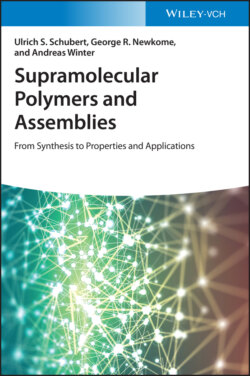Читать книгу Supramolecular Polymers and Assemblies - Andreas Winter - Страница 18
1.4 Beyond Classical Supramolecular Polymerization
ОглавлениеThe three aforementioned mechanisms represent the classical examples for how supramolecular polymerization might proceed. Going beyond these, various strategies have been developed to circumvent some limitations arising from the traditional approaches [37]. In particular, the control over the molar mass and the dispersity remain as major challenges. The living supramolecular polymerization aims to adopt the key features from covalent living polymerizations, i.e. good kinetic control over the initiation and propagation steps, and to transfer these into self‐assembly processes [132]. Meijer and coworkers identified the NEP process (see Section 1.3.3) as the most appropriate mechanism for this purpose. It was shown that a finely tuned balance between attractive (i.e. a combination of various non‐covalent interactions) and repulsive forces (i.e. electrostatic interactions) was crucial to enable control over the supramolecular polymerization [133]. Based on an interplay between isodesmic and cooperative pathways, Ogi et al. realized that the supramolecular self‐assembly of a porphyrin monomer equipped with H‐bonding entities and hydrophobic alkyl chains into nanofibers of narrow length dispersities (Đ value of 1.10) [134]. In the same context, the “living crystallization,” i.e. the seeded growth of block copolymers into micrometer‐sized micelles, needs also to be mentioned [135]. In particular, the Manners and Winnick groups employed this strategy to assemble block copolymers in a highly controlled fashion.
A “supramonomer,” i.e. a monomer that was formed via non‐covalent interactions, can be polymerized using covalent or supramolecular polymerization techniques [37]. The covalent polymerization of preformed metal complexes into metallopolymers represents one of the most common applications in this respect (see also Chapter 4) [36, 136]. However, these polymerizations (as well as other examples, e.g. [137, 138]) do not offer sufficient control over the molar mass (distribution) since the reactions typically follow a step‐growth mechanism. Nonetheless, this approach provides an alternative to the direct supramolecular polymerizations and, thus, widens the options to prepare tailor‐made polymers that incorporate supramolecular units.
The self‐sorting of molecular components due to the selectivity of non‐covalent binding represents an established approach to assemble alternating supramolecular polymers, in particular when making use of orthogonal types of secondary interactions (see Chapter 11) [139]. Huang et al. demonstrated that supramolecular self‐sorting of two different cucurbit[n]uril derivatives (n = 7 and 8), in the presence of an appropriate homoditopic guest, can even proceed with reasonable control (see also Chapter 7) [140]. At an equimolar ratio of all three components, a maximum molar mass (Mw) of 9.7 × 104 g mol−1 was obtained; the dispersity of the polymer was c. 1.5 and thus remarkably low for such a supramolecular polymerization.
As one further example, the stimuli‐controlled supramolecular polymerization needs to be mentioned. Yang et al. proposed that supramolecular polymerizations, driven by external stimuli, might proceed with good control (assuming optimized reaction conditions) [37]. However, the broad range of stimuli‐responsive polymers reported so far basically rely on the ability to reversibly polymerize/depolymerize when, e.g. the pH‐switchability of ionic interactions (Chapter 2) or the redox‐switchability of host‐guest interactions (Chapter 7).
Not only supramolecular polymers are typically assembled under thermodynamic control, but also materials generated in kinetically trapped or metastable states have also been reported [40, 141]. For supramolecular polymers, which were assembled far from equilibrium, unique possibilities have been suggested: inherent dynamic nature, adaptivity, and spatiotemporal controllability [142–144]. Noteworthy, many natural self‐assembled systems operate in such states and fulfill crucial functions [145]. Kinetic control of a supramolecular polymerization can be achieved utilizing strong non‐covalent interactions; thus, materials in non‐dissipative, nonequilibrium states can be formed (Figure 1.15). In such processes, the experimental details are of significant importance since nonlinear phenomena (e.g. nucleation or multiple competitive growth) are known to contribute to the outcome of the supramolecular self‐assembly (e.g. the nanoscale morphology of the obtained materials) [40]. Remarkable progress has been made to understand the kinetics and pathway complexity, and, today, the selection of a specific self‐assembly pathway is possible by cautious optimization of the experimental details. As a result, one can generate supramolecular materials with different functional properties, even from a single monomer. The fourth case, which is the dissipative nonequilibrium state, is known from living systems. In these supramolecular assemblies, energy is continuously consumed to account for their stability. In Nature, nucleobase triphosphates represent the main energy resources, which can control the nonequilibrium self‐assembly process in a highly spatiotemporal fashion – a prerequisite for cells to perform their complex functions (e.g. cell division, motility, and intracellular transport) [146]. The evolution of this field of research, an in‐depth discussion of the underlying mechanisms, and selection criteria to assemble supramolecular polymers in nonequilibrium states can be found in various recent reviews [40, 145]. In a recent example, Xu and coworkers demonstrated that only a photo‐reduced homoditopic viologen monomer gave a supramolecular polymer due to the formation of host–guest complexes with cucurbit[8]uril; whereas, under ambient conditions, depolymerization occurred due to a reoxidative process (see Chapter 7) [147].
Figure 1.15 Illustration of the various thermodynamic states in supramolecular polymerizations on Gibbs free energy landscape.
Source: Sorrenti et al. [40]. Licenced under CC BY 3.0.
